共计 29573 个字符,预计需要花费 74 分钟才能阅读完成。
需求分析:
1. 前端需支持更大的访问量,单台 Web 服务器已无法满足需求了,则需扩容 Web 服务器;
2. 虽然动态内容可交由后端的 PHP 服务器执行,但静态页面还需要 Web 服务器自己解析,那是否意味着多台 Web 服务器都需要在各自的系统中都存有一份静态页面数据呢?
其实这样也不是不可以,毕竟文件本地访问,速度还是有优势的,但这却涉及到多台 Web 服务器间内容的一致性问题,这种问题也不可避免;
那么如果能将静态页面集中存放,所有 Web 服务器都来集中地取文件,对于文件的一致性就有了保障,这个集中地就叫做“文件共享服务器”;
文件共享有多种方式,FTP,NFS,Samba 等,而其中 NFS 作为网络文件系统,允许一个系统通过网络共享目录和文件,通过使用 NFS,用户和程序可以像访问本地文件一样访问远端系统上的文件,这种近似访问本地文件系统的架构貌似很符合我们的需求,我们现在就来实现这个需求!
需求实现:
1.web1 充当 http 服务器和 DNS 解析服务器,客户端到 web1 和 web2 的请求,如果是静态资源请求通过 php 主机的 NFS 服务挂载的存储返回结果
2.web1 和 web2 对于客户端动态资源请求都反向代理到后端 php 服务器进行执行后返回结果
3.web1 和 web2 实现 DNS 轮询,客户端访问博客网站是负载均衡的。
4. 建立 wordpress 博客
5. 数据库存储 wordpress 博客的各种数据
实验架构:
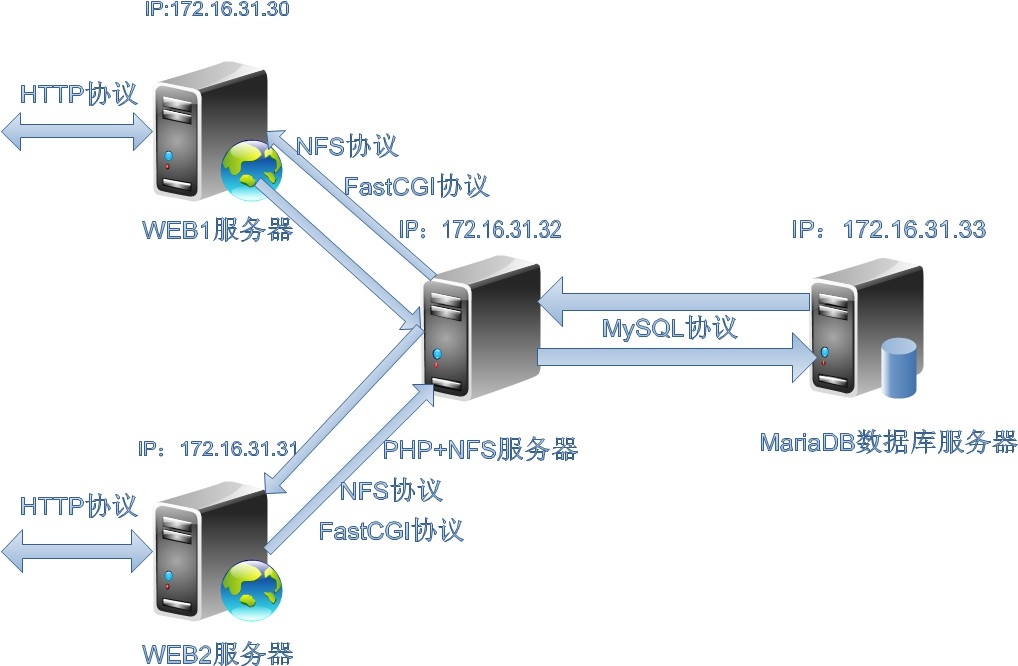
Ubuntu 14.04 配置 LAMP+phpMyAdmin PHP(5.5.9)开发环境 http://www.linuxidc.com/Linux/2014-10/107924.htm
Windows 7 下硬盘安装 Ubuntu 14.10 图文教程 http://www.linuxidc.com/Linux/2014-10/108430.htm
U 盘安装 Ubuntu 14.10 http://www.linuxidc.com/Linux/2014-10/108402.htm
Ubuntu 14.10 正式发布下载 http://www.linuxidc.com/Linux/2014-10/108363.htm
Ubuntu 14.04 LTS 如何升级到 Ubuntu 14.10 http://www.linuxidc.com/Linux/2014-10/108381.htm
Ubuntu 14.10 下安装 LAMP 服务图文详解 http://www.linuxidc.com/Linux/2014-12/110082.htm
部署实现
一.DNS服务器在 web1 上的实现
开发环境配置
1 | # yum –y groupinstall Development Tools |
配置 DNS 服务器:
安装 DNS 服务器软件bind
1 | #yum –y install bind |
配置 DNS 主配置文件:
1 2 3 4 5 6 7 8 9 10 11 12 13 14 15 16 17 18 19 20 21 22 23 24 25 26 27 28 29 30 31 32 33 34 35 36 37 38 39 40 41 42 43 44 45 | # vim /etc/named.conf////named.conf////Provided by Red Hat bind package to configure the ISC BIND named(8) DNS// serveras a caching only nameserver (as a localhost DNS resolver only).//// See/usr/share/doc/bind*/sample/ for example named configuration files.// options {// listen-on port 53 {127.0.0.1;};// listen-on-v6 port 53 {::1;}; directory "/var/named"; dump-file "/var/named/data/cache_dump.db"; statistics-file"/var/named/data/named_stats.txt"; memstatistics-file"/var/named/data/named_mem_stats.txt";// allow-query {localhost;}; recursion yes; // dnssec-enable yes;// dnssec-validation yes;// dnssec-lookaside auto; /* Path to ISC DLV key */ /*bindkeys-file"/etc/named.iscdlv.key"; managed-keys-directory"/var/named/dynamic"; */}; logging { channel default_debug { file"data/named.run"; severity dynamic; };}; zone"." IN { type hint; file "named.ca";}; include"/etc/named.rfc1912.zones";include "/etc/named.root.key"; |
配置主区域文件:只是在文件尾部添加正向区域
1 2 3 4 5 | # vim /etc/named.rfc1912.zoneszone"stu31.com" IN { type master; file "stu31.com.zone";}; |
配置正向区域解析库文件:
这里让客户端查询 http 服务器时能轮换查询到两台 web 服务器。
1 2 3 4 5 6 7 8 9 10 11 12 13 14 15 | # vim/var/named/stu31.com.zone$TTL 600$ORIGINstu31.com.@ IN SOA ns.stu31.com. root.stu31.com. ( 2014122301 1H 3M 5D 6H )@ IN NS ns IN MX 5 mailns IN A 172.16.31.30www IN A 172.16.31.30www IN A 172.16.31.31mail IN A 172.16.31.30 |
配置文件语法检查:
1 2 3 | #named-checkzone stu31.com /var/named/stu31.com.zone zonestu31.com/IN: loaded serial 2014122301OK |
启动 DNS 服务:
1 2 3 | # servicenamed startGenerating/etc/rndc.key: [OK]Starting named: [OK] |
测试全部区域解析:
1 2 3 4 5 6 7 8 9 10 11 12 13 14 15 16 | # dig -taxfr stu31.com @172.16.31.30 ;<<>> DiG 9.8.2rc1-RedHat-9.8.2-0.30.rc1.el6 <<>> -taxfr stu31.com @172.16.31.30;; globaloptions: +cmdstu31.com. 600 IN SOA ns.stu31.com. root.stu31.com.2014122301 3600 180 432000 21600stu31.com. 600 IN NS ns.stu31.com.stu31.com. 600 IN MX 5 mail.stu31.com.mail.stu31.com. 600 IN A 172.16.31.30ns.stu31.com. 600 IN A 172.16.31.30www.stu31.com. 600 IN A 172.16.31.30www.stu31.com. 600 IN A 172.16.31.31stu31.com. 600 IN SOA ns.stu31.com.root.stu31.com. 2014122301 3600 180 432000 21600;; Querytime: 1 msec;;SERVER: 172.16.31.30#53(172.16.31.30);; WHEN:Wed Dec 24 02:44:40 2014;; XFR size: 8 records (messages 1, bytes 210) |
DNS服务器安装完毕!这里是最简单的正向区域的实现,果有不清楚的话,我前面的博文有详细介绍。
二. apache服务器在 web1 和web2上的实现
httpd的安装同时在 web1 和web2上安装:
将 DNS 服务器地址指向172.16.31.30
开发环境配置:
1 2 | # yum –y groupinstall Development Tools# yum install -ypcre-devel openssl-devel |
编译安装apr:
1 2 3 4 | # tar xf apr-1.5.0.tar.bz2# cd apr-1.5.0# ./configure--prefix=/usr/local/apr# make && make install |
编译安装apr-util
1 2 3 4 | # tar xf apr-util-1.5.3.tar.bz2# cd apr-util-1.5.3# ./configure --prefix=/usr/local/apr-util--with-apr=/usr/local/apr# make && make install |
编译安装httpd-2.4.10
1 2 3 4 | # tar xf httpd-2.4.10.tar.bz2# cd httpd-2.4.10# ./configure --prefix=/usr/local/apache --sysconfdir=/etc/httpd24 --enable-so--enable-ssl --enabletc/httpd24 --enable-so --enable-ssl --enable-rewrite--with-z --with-pcre --with-apr=/usr/local/apr--with-apr-util=/usr/local/apr-util --enable-modules=most--enable-mpms-shared=all --with-mpm=event#make && make install |
Apache服务脚本创建:
复制一个系统上原有的 httpd 的脚本更改如下:
#cp /etc/rc.d/init.d/httpd /etc/rc.d/init.d/httpd24
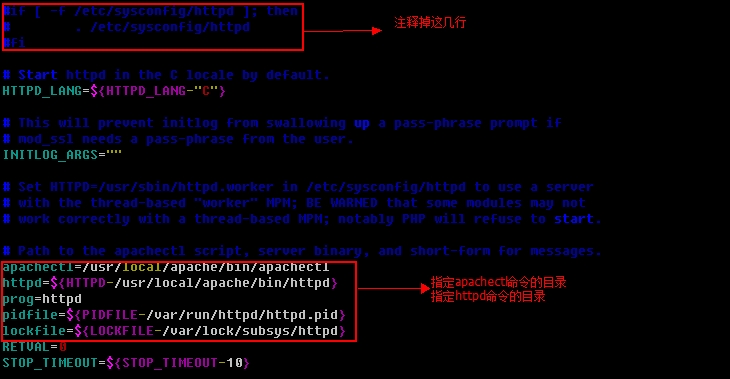
加入系统服务:
1 2 | #chkconfig –add httpd24#chkconfig httpd24 on |
启动 httpd 服务:
1 2 3 | # servicehttpd24 restartStoppinghttpd: [OK]Startinghttpd: [OK] |
Web服务器基础部分搭建完成,只需要后续虚拟主机配置与 PHP 结合。
三. MariaDB数据库服务器安装
MariaDB服务器的 DNS 指向172.16.31.30
开发环境配置:
1 2 | # yum groupinstall Development Tools# yum -y install pcre-devel openssl-devel |
XFS文件系统支持:
1 | # yum install xfsprogs |
服务器数据库数据文件存储考虑到安全性,我将创建一个 LVM 进行数据库数据文件的存储,并采用新型文件系统 XFS 来提高数据库服务器的性能。
格式化磁盘:
1 2 | # echo -n -e"n\np\n3\n\n+10G\nt\n3\n8e\n\w\n" |fdisk /dev/sda# partx -a /dev/sda |
创建LVM:
1 2 3 | # pvcreate/dev/sda3# vgcreate myvg/dev/sda3# lvcreate -L 10G -n mylv myvg |
创建 xfs 文件系统:
1 2 | # mkfs -t xfs /dev/myvg/mylv# blkid /dev/myvg/mylv |
自动挂载,在 /etc/fstab 文件尾部添加:
1 2 | # vim /etc/fstabUUID="ba4e1e6c-3b7f-4f66-95b1-f51f8792288d" /mydata xfs defaults 0 0 |
创建数据库管理用户:
1 | # useradd -M -s /sbin/nologin -d /mydata/data -r MySQL |
创建数据库数据文件存储目录:
1 | # mkdir /mydata/data |
并给予 mysql 用户数据库数据文件存储目录管理权限:
1 | # chown -R mysql:mysql /mydata/data/ |
解压数据库二进制源码包:
1 2 | # tar xf mariadb-10.0.10-linux-x86_64.tar.gz -C /usr/local/# cd /usr/local/ |
创建软链接:
1 2 | # ln -s mariadb-10.0.10-linux-x86_64/ mysql# cd mysql/ |
初始化安装MariaDB:
1 | # scripts/mysql_install_db --user=mysql--datadir=/mydata/data |
mariadb配置文件创建及更改,有模版
安装系统的时候,/etc/路径下有一个 my.cnf 的,这里换个路径
1 2 3 4 5 6 7 8 9 10 11 12 13 14 15 16 17 18 19 20 | # mkdir /etc/mysql# cp support-files/my-huge.cnf /etc/mysql/my.cnf# vim /etc/mysql/my.cnf[mysqld]datadir = /mydata/dataport = 3306socket =/tmp/mysql.sockskip-external-lockingkey_buffer_size = 384Mmax_allowed_packet = 1Mtable_open_cache = 512sort_buffer_size = 2Mread_buffer_size = 2Mread_rnd_buffer_size = 8Mmyisam_sort_buffer_size = 64Mthread_cache_size = 8query_cache_size = 32Minnodb_file_per_table = on# Try number of CPU's*2 for thread_concurrencythread_concurrency = 8 |
mariadb服务脚本创建
1 2 3 4 5 6 7 8 | # cp support-files/mysql.server /etc/rc.d/init.d/mysqld# chkconfig --add mysqld# chkconfig mysqld on# service mysqld startStarting MySQL. [OK]# ls /mydata/data/aria_log.00000001 ib_logfile0 mysql mysql.stu31.com.pidaria_log_control ib_logfile1 mysql-bin.000001 performance_schema |
mysqld服务的一些设置
设置环境变量:
1 2 | # vim /etc/profile.d/mysqld.shexport PATH=/usr/local/mysql/bin:$PATH |
加载环境变量:
1 | # source /etc/profile.d/mysqld.sh |
输出 mysql 的头文件至系统头文件路径/usr/include。
1 | # ln -sv /usr/local/mysql/include /usr/include/mysql |
输出 mysql 的库文件给系统库查找路径,系统重新加载:
1 2 | # echo '/usr/local/mysql/lib' > /etc/ld.so.conf.d/mysql.conf# ldconfig |
测试客户端启动:
1 2 3 4 5 6 7 8 9 10 11 12 13 14 15 16 17 18 19 | # mysqlWelcome to the MariaDB monitor. Commands end with ; or \g.Your MariaDB connection id is 4Server version: 10.0.10-MariaDB-log MariaDB Server Copyright (c) 2000, 2014, Oracle, SkySQL Ab and others. Type 'help;' or '\h' for help. Type '\c' to clear the current inputstatement. MariaDB [(none)]> select version();+---------------------+| version() |+---------------------+| 10.0.10-MariaDB-log |+---------------------+1 row in set (0.00 sec) MariaDB [(none)]> \qBye |
给数据库设置一个密码。
1 2 3 | # mysqladmin -u root passwordNew password:Confirm new password: |
MariaDB安装完毕,只是基本的数据库环境,后面还需要数据库与博客网站结合
更多详情见请继续阅读下一页的精彩内容:http://www.linuxidc.com/Linux/2014-12/110943p2.htm
四.PHP服务器上安装基于 FastCGI 的实现
PHP服务器的 DNS 设置成172.16.31.30
开发环境配置:
1 2 | # yumgroupinstall Development Tools#yum install –y pcre-devel openssl-devellibxml2-devel php-gd freetype-devel mbstring |
编译安装php-5.6.4
1 2 3 | #tar xf php-5.6.4.tar.xz -C /usr/src/# cd/usr/src/php-5.6.4/#./configure --prefix=/usr/local/php --with-MySQL=mysqlnd--with-pdo-mysql=mysqlnd --with-mysqli=mysqlnd --with-openssl --enable-mbstring--with-freetype-dir --with-jpeg-dir --with-png-dir --with-zlib--with-libxml-dir=/usr --with-gd --enable-xml --enable-sockets --enable-fpm--with-mcrypt --with-config-file-path=/etc--with-config-file-scan-dir=/etc/php.d --with-bz2 --enable-maintainer-zts |
安装:
1 | #make&& make install |
为 PHP 服务器提供配置文件:
1 | #cp php.ini-production /etc/php.ini |
为 php 提供 Sys 启动控制脚本,加入开机启动。
1 2 3 4 5 6 | # cp sapi/fpm/init.d.php-fpm /etc/rc.d/init.d/php-fpm# chmod +x /etc/rc.d/init.d/php-fpm# chkconfig --list php-fpmservice php-fpm supports chkconfig, but is not referenced in anyrunlevel (run 'chkconfig --add php-fpm')# chkconfig --add php-fpm# chkconfig php-fpm on |
为 php-fpm 提供配置文件,编辑 php-fpm 配置文件,修改监听端口,默认是127.0.0.1。
1 2 3 4 5 6 7 8 | # cp /usr/local/php/etc/php-fpm.conf.default/usr/local/php/etc/php-fpm.conf# vim /usr/local/php/etc/php-fpm.confpm.max_children = 50pm.start_servers = 5pm.min_spare_servers = 2pm.max_spare_servers = 8pid = /usr/local/php5/var/run/php-fpm.pidlisten = 172.16.31.22:9000 |
启动 php-fpm,检查php 监听端口。
1 2 3 4 | # service php-fpm startStarting php-fpm done# ss -tunl |grep 9000tcp LISTEN 0 128 172.16.31.22:9000 *:* |
环境变量设置:
1 2 3 4 5 6 7 | # vim /etc/profile.d/php.shexport PATH=/usr/local/php/bin:$PATH# source /etc/profile.d/php.sh# php -vPHP 5.4.26 (cli) (built: Dec 21 2014 01:53:51)Copyright (c) 1997-2014 The PHP GroupZend Engine v2.4.0, Copyright (c) 1998-2014 Zend Technologies |
PHP部分配置完成,基本的 php 服务器环境,后面需要与 web 服务器结合。
五. PHP服务器上启用 NFS 服务
创建一个目录或者提供一个特定的文件系统;亦可以参考上面的为数据库数据文件存储创建的特定文件系统:
# mkdir /web
创建 wordpress 博客的网站存放目录,我们将其共享出去让 web 服务器使用:
#mkdir /web/blog
查看 NFS 软件是否安装:
1 2 | # rpm -qanfs-utilsnfs-utils-1.2.3-54.el6.x86_64 |
NFS服务的配置文件为 /etc/exports,这个文件是NFS 的主要配置文件,不过系统并没有默认值,所以这个文件不一定会存在,可能要使用 vim 手动建立,然后在文件里面写入配置内容。
1 2 | # cat /etc/exports/web/blog 172.16.31.30(rw,async,no_root_squash)172.16.31.31(rw,async,no_root_squash) |
# 配置共享目录为可读写,客户端 root 用户权限不压缩
/etc/exports文件内容格式:
<输出目录 > [ 客户端 1 选项(访问权限 , 用户映射 , 其他)] [客户端 2 选项(访问权限 , 用户映射 , 其他)]
开启 nfs 服务:
1 2 3 4 5 6 7 8 9 10 11 | [root@php ~]# service nfs restartShutting down NFS daemon: [OK]Shutting down NFS mountd: [OK]Shutting down NFS quotas: [OK]Shutting down NFS services: [OK]Shutting down RPC idmapd: [OK]Starting NFS services: [OK]Starting NFS quotas: [OK]Starting NFS mountd: [OK]Starting NFS daemon: [OK]Starting RPC idmapd: [OK] |
查看本地 NFS 文件系统共享的目录:
1 2 3 | # showmount -e 172.16.31.32Export list for 172.16.31.32:/web/blog 172.16.31.31,172.16.31.30 |
NFS文件系统建立完成。
六. 在 web1 和web2上挂载 NFS 文件系统到本地目录
NFS客户端配置
这里的客户端就是前端的 2 台Web服务器,先挂载共享目录,然后测试其读写功能
在客户机上执行 mount 命令 , 它向服务器上的端口映射器发出一个 RPC 调用来获得服
务器上安装守护程序的端口号。客户和端口映射器交互既可以使用 TCP 也可以使用 UDP, 但一般使用UDP。
将 NFS 文件系统挂载到 web 服务器上
我们现在 web 服务器上查看 NFS 文件系统共享的目录:
1 2 3 | # showmount -e172.16.31.32Export list for172.16.31.32:/web/blog172.16.31.31,172.16.31.30 |
我们先在 web 服务器上创建本地目录:/web/blog
1 | [root@web1 ~]#mkdir /web/blog -pv |
挂载 NFS 共享的文件目录到本地:
可以使用临时挂载:
1 | [root@web1 ~]#mount -t nfs 172.16.31.32:/web/blog /web/blog |
也可使用开机系统自动挂载:
1 2 | [root@web1 ~]#vim /etc/fstab172.16.31.32:/web/blog /web/blog nfs defaults,_netdev 0 0 |
这里的 _netdev 选项是为了防止远程 NFS 服务器关闭后本地系统不能启动
挂载完成后查看挂载是否成功:
[root@web1 ~]#mount
/dev/mapper/vg0-rooton / type ext4 (rw)
proc on /proctype proc (rw)
sysfs on /systype sysfs (rw)
devpts on/dev/pts type devpts (rw,gid=5,mode=620)
tmpfs on/dev/shm type tmpfs (rw)
/dev/sda1 on/boot type ext4 (rw)
/dev/mapper/vg0-usron /usr type ext4 (rw)
/dev/mapper/vg0-varon /var type ext4 (rw)
none on/proc/sys/fs/binfmt_misc type binfmt_misc (rw)
sunrpc on/var/lib/nfs/rpc_pipefs type rpc_pipefs (rw)
172.16.31.32:/web/blog on/web/blog type nfs (rw,vers=4,addr=172.16.31.32,clientaddr=172.16.31.30)
七. 安装 wordpress 博客系统
1. 配置 web 服务器的虚拟主机支持:
开启 FastCGI 模块和 PHP 支持及开启虚拟主机。
#vim /etc/httpd24/httpd.conf
LoadModuleproxy_module modules/mod_proxy.so
LoadModuleproxy_fcgi_modulemodules/mod_proxy_fcgi.so
<IfModuledir_module>
DirectoryIndex index.php index.html
</IfModule>
AddTypeapplication/x-compress .Z
AddType application/x-gzip.gz .tgz
AddTypeapplication/x-httpd-php .php
AddTypeapplication/x-httpd-php-source .phps
Include/etc/httpd24/extra/httpd-vhosts.conf
配置虚拟主机配置文件:
1 2 3 4 5 6 7 8 9 10 11 12 13 14 | #vim/etc/httpd24/extra/httpd-vhosts.conf<VirtualHost 172.16.31.30:80>DocumentRoot"/web/blog"ServerName www.stu31.comProxyRequests OffProxyPassMatch^/(.*\.php)$ fcgi://172.16.31.32:9000/www/blog/$1ErrorLog"/web/blog/logs/error_log"CustomLog"/web/blog/logs/access_log" common<Directory"/web/blog/logs"> Options none AllowOverride none Require all granted</Directory></VirtualHost> |
注意:
A. 需要在 nfs 共享文件目录中创建日志文件目录logs
#mkdir/web/blog/logs/
B.web服务器的静态资源请求是到 nfs 共享文件目录 /web/blog 中返回结果,而涉及到动态资源的请求是反向代理到 php 服务器上的网站目录 /www/blog 中执行后返回结果。
C. 前端 2 台web服务器都需要配置好虚拟主机。
2. 在 NFS 共享服务器上安装 wordpress 博客系统
在 php 服务器上创建动态资源存放目录:
#mkdir /www/blog
解压 wordpress 博客程序:
# unzip wordpress-3.2.1-zh_CN.zip
移动程序到 NFS 文件共享目录:
# mv wordpress/* /web/blog/
3. 配置 wordpress 博客系统与数据库结合
创建 wordpress 的配置文件:
1 2 | #cd /web/blog# cp wp-config-sample.php wp-config.php |
写入数据库名称,用户名,密码及数据库服务器 IP 地址:
1 2 3 4 5 6 7 8 9 10 11 12 13 14 15 16 17 18 19 | #vim wp-config.php// **MySQL 设置 - 具体信息来自您正在使用的主机 ** ///**WordPress 数据库的名称 */define('DB_NAME','wpdb'); /** MySQL 数据库用户名 */define('DB_USER','wpadmin'); /** MySQL 数据库密码 */define('DB_PASSWORD','Oracle'); /** MySQL 主机 */define('DB_HOST','172.16.31.33'); /** 创建数据表时默认的文字编码 */define('DB_CHARSET','utf8'); /** 数据库整理类型。如不确定请勿更改 */define('DB_COLLATE', ''); |
切换到数据库服务器,在数据库添加库,授权,添加授权密码
1 2 3 4 5 6 7 8 9 10 11 12 13 14 15 16 17 18 19 20 21 | [root@mysqlmysql]# mysql -u root -pEnter password:Welcome to the MariaDB monitor. Commands end with ; or \g.Your MariaDB connection id is 8Server version: 10.0.10-MariaDB-log MariaDB Server Copyright (c) 2000, 2014, Oracle, SkySQL Ab and others. Type 'help;' or '\h' for help. Type '\c' to clear the current inputstatement. MariaDB [(none)]> create schema wpdb;Query OK, 1 row affected (0.04 sec) MariaDB [(none)]> grant all on wpdb.* to 'wpadmin'@'172.16.%.%'identified by 'oracle';Query OK, 0 rows affected (0.05 sec) MariaDB [(none)]> flush privileges;Query OK, 0 rows affected (0.00 sec) MariaDB [(none)]> \qBye |
4. 重新启动 httpd 服务
1 2 3 | # servicehttpd24 restart Stoppinghttpd: [OK]Startinghttpd: [OK] |
八. 实现测试
我们通过浏览器访问博客网站,我这里是一个在虚拟机上访问,一个在实体机上访问:
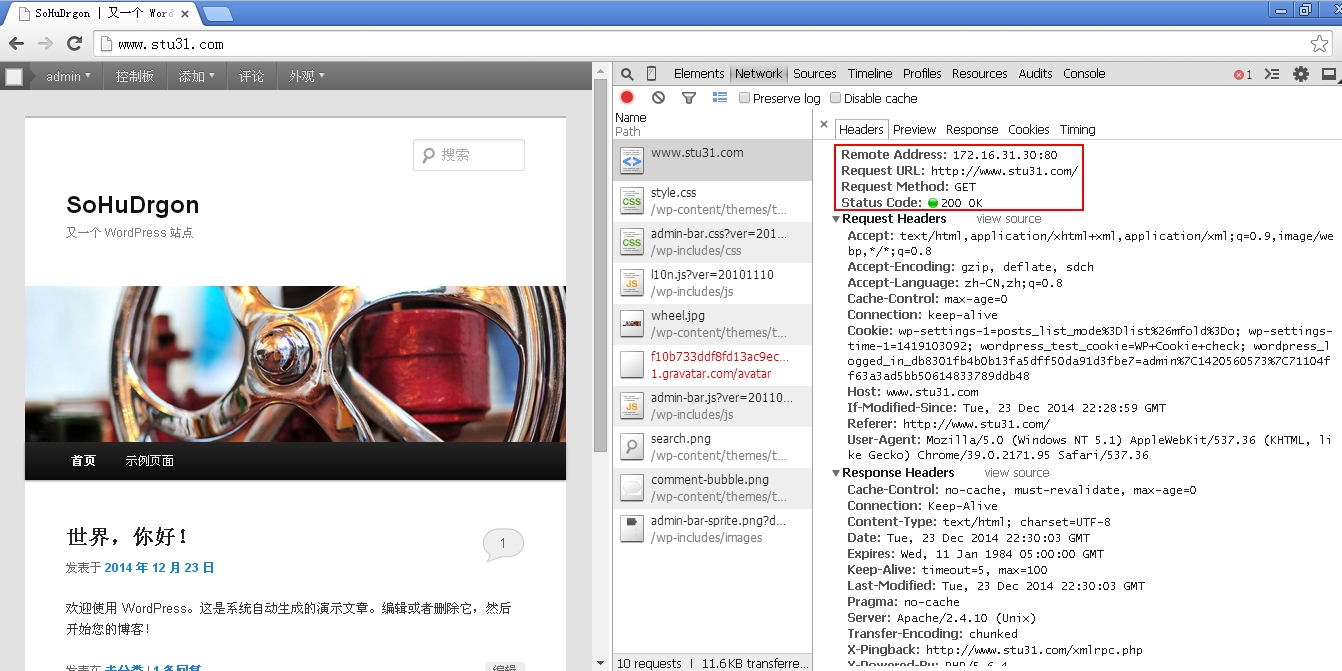
上图的访问是在 web1 完成的
下图的访问是在 web2 完成的
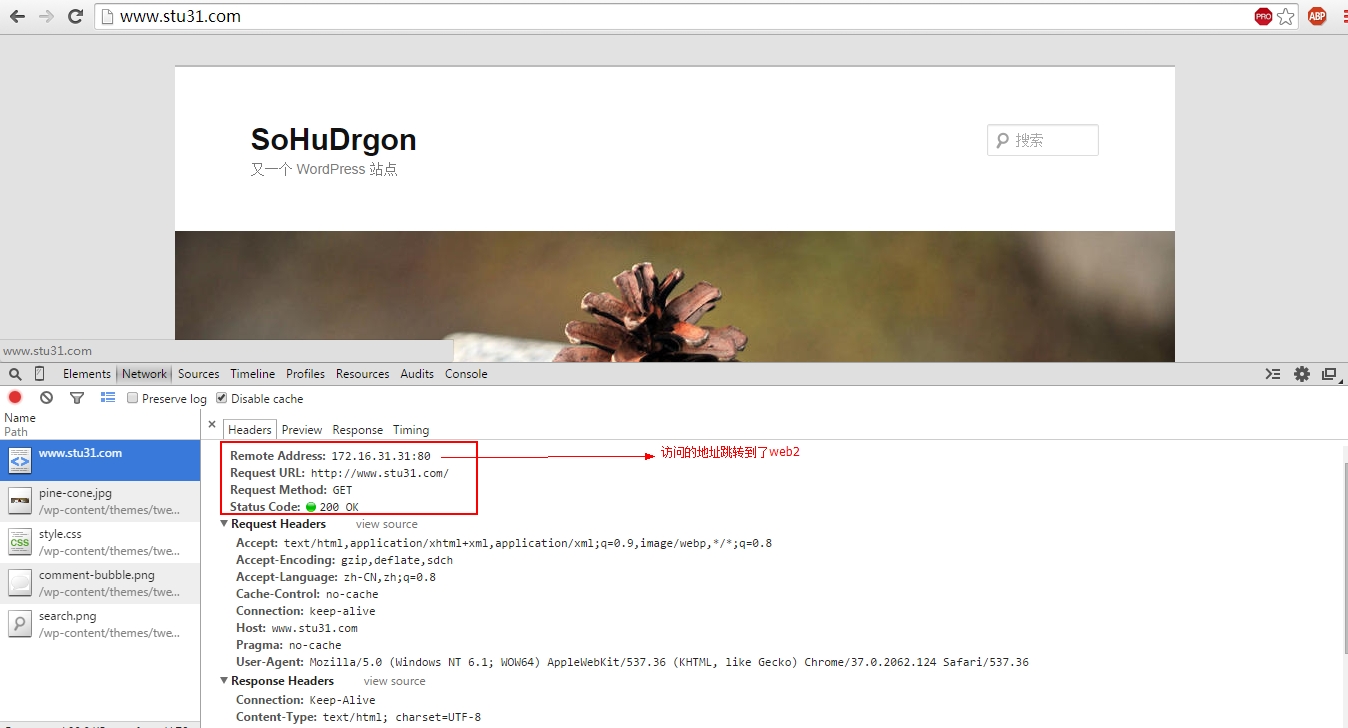
结果非常完美哦!o(∩_∩)o
需求分析:
1. 前端需支持更大的访问量,单台 Web 服务器已无法满足需求了,则需扩容 Web 服务器;
2. 虽然动态内容可交由后端的 PHP 服务器执行,但静态页面还需要 Web 服务器自己解析,那是否意味着多台 Web 服务器都需要在各自的系统中都存有一份静态页面数据呢?
其实这样也不是不可以,毕竟文件本地访问,速度还是有优势的,但这却涉及到多台 Web 服务器间内容的一致性问题,这种问题也不可避免;
那么如果能将静态页面集中存放,所有 Web 服务器都来集中地取文件,对于文件的一致性就有了保障,这个集中地就叫做“文件共享服务器”;
文件共享有多种方式,FTP,NFS,Samba 等,而其中 NFS 作为网络文件系统,允许一个系统通过网络共享目录和文件,通过使用 NFS,用户和程序可以像访问本地文件一样访问远端系统上的文件,这种近似访问本地文件系统的架构貌似很符合我们的需求,我们现在就来实现这个需求!
需求实现:
1.web1 充当 http 服务器和 DNS 解析服务器,客户端到 web1 和 web2 的请求,如果是静态资源请求通过 php 主机的 NFS 服务挂载的存储返回结果
2.web1 和 web2 对于客户端动态资源请求都反向代理到后端 php 服务器进行执行后返回结果
3.web1 和 web2 实现 DNS 轮询,客户端访问博客网站是负载均衡的。
4. 建立 wordpress 博客
5. 数据库存储 wordpress 博客的各种数据
实验架构:

Ubuntu 14.04 配置 LAMP+phpMyAdmin PHP(5.5.9)开发环境 http://www.linuxidc.com/Linux/2014-10/107924.htm
Windows 7 下硬盘安装 Ubuntu 14.10 图文教程 http://www.linuxidc.com/Linux/2014-10/108430.htm
U 盘安装 Ubuntu 14.10 http://www.linuxidc.com/Linux/2014-10/108402.htm
Ubuntu 14.10 正式发布下载 http://www.linuxidc.com/Linux/2014-10/108363.htm
Ubuntu 14.04 LTS 如何升级到 Ubuntu 14.10 http://www.linuxidc.com/Linux/2014-10/108381.htm
Ubuntu 14.10 下安装 LAMP 服务图文详解 http://www.linuxidc.com/Linux/2014-12/110082.htm
部署实现
一.DNS服务器在 web1 上的实现
开发环境配置
1 | # yum –y groupinstall Development Tools |
配置 DNS 服务器:
安装 DNS 服务器软件bind
1 | #yum –y install bind |
配置 DNS 主配置文件:
1 2 3 4 5 6 7 8 9 10 11 12 13 14 15 16 17 18 19 20 21 22 23 24 25 26 27 28 29 30 31 32 33 34 35 36 37 38 39 40 41 42 43 44 45 | # vim /etc/named.conf////named.conf////Provided by Red Hat bind package to configure the ISC BIND named(8) DNS// serveras a caching only nameserver (as a localhost DNS resolver only).//// See/usr/share/doc/bind*/sample/ for example named configuration files.// options {// listen-on port 53 {127.0.0.1;};// listen-on-v6 port 53 {::1;}; directory "/var/named"; dump-file "/var/named/data/cache_dump.db"; statistics-file"/var/named/data/named_stats.txt"; memstatistics-file"/var/named/data/named_mem_stats.txt";// allow-query {localhost;}; recursion yes; // dnssec-enable yes;// dnssec-validation yes;// dnssec-lookaside auto; /* Path to ISC DLV key */ /*bindkeys-file"/etc/named.iscdlv.key"; managed-keys-directory"/var/named/dynamic"; */}; logging { channel default_debug { file"data/named.run"; severity dynamic; };}; zone"." IN { type hint; file "named.ca";}; include"/etc/named.rfc1912.zones";include "/etc/named.root.key"; |
配置主区域文件:只是在文件尾部添加正向区域
1 2 3 4 5 | # vim /etc/named.rfc1912.zoneszone"stu31.com" IN { type master; file "stu31.com.zone";}; |
配置正向区域解析库文件:
这里让客户端查询 http 服务器时能轮换查询到两台 web 服务器。
1 2 3 4 5 6 7 8 9 10 11 12 13 14 15 | # vim/var/named/stu31.com.zone$TTL 600$ORIGINstu31.com.@ IN SOA ns.stu31.com. root.stu31.com. ( 2014122301 1H 3M 5D 6H )@ IN NS ns IN MX 5 mailns IN A 172.16.31.30www IN A 172.16.31.30www IN A 172.16.31.31mail IN A 172.16.31.30 |
配置文件语法检查:
1 2 3 | #named-checkzone stu31.com /var/named/stu31.com.zone zonestu31.com/IN: loaded serial 2014122301OK |
启动 DNS 服务:
1 2 3 | # servicenamed startGenerating/etc/rndc.key: [OK]Starting named: [OK] |
测试全部区域解析:
1 2 3 4 5 6 7 8 9 10 11 12 13 14 15 16 | # dig -taxfr stu31.com @172.16.31.30 ;<<>> DiG 9.8.2rc1-RedHat-9.8.2-0.30.rc1.el6 <<>> -taxfr stu31.com @172.16.31.30;; globaloptions: +cmdstu31.com. 600 IN SOA ns.stu31.com. root.stu31.com.2014122301 3600 180 432000 21600stu31.com. 600 IN NS ns.stu31.com.stu31.com. 600 IN MX 5 mail.stu31.com.mail.stu31.com. 600 IN A 172.16.31.30ns.stu31.com. 600 IN A 172.16.31.30www.stu31.com. 600 IN A 172.16.31.30www.stu31.com. 600 IN A 172.16.31.31stu31.com. 600 IN SOA ns.stu31.com.root.stu31.com. 2014122301 3600 180 432000 21600;; Querytime: 1 msec;;SERVER: 172.16.31.30#53(172.16.31.30);; WHEN:Wed Dec 24 02:44:40 2014;; XFR size: 8 records (messages 1, bytes 210) |
DNS服务器安装完毕!这里是最简单的正向区域的实现,果有不清楚的话,我前面的博文有详细介绍。
二. apache服务器在 web1 和web2上的实现
httpd的安装同时在 web1 和web2上安装:
将 DNS 服务器地址指向172.16.31.30
开发环境配置:
1 2 | # yum –y groupinstall Development Tools# yum install -ypcre-devel openssl-devel |
编译安装apr:
1 2 3 4 | # tar xf apr-1.5.0.tar.bz2# cd apr-1.5.0# ./configure--prefix=/usr/local/apr# make && make install |
编译安装apr-util
1 2 3 4 | # tar xf apr-util-1.5.3.tar.bz2# cd apr-util-1.5.3# ./configure --prefix=/usr/local/apr-util--with-apr=/usr/local/apr# make && make install |
编译安装httpd-2.4.10
1 2 3 4 | # tar xf httpd-2.4.10.tar.bz2# cd httpd-2.4.10# ./configure --prefix=/usr/local/apache --sysconfdir=/etc/httpd24 --enable-so--enable-ssl --enabletc/httpd24 --enable-so --enable-ssl --enable-rewrite--with-z --with-pcre --with-apr=/usr/local/apr--with-apr-util=/usr/local/apr-util --enable-modules=most--enable-mpms-shared=all --with-mpm=event#make && make install |
Apache服务脚本创建:
复制一个系统上原有的 httpd 的脚本更改如下:
#cp /etc/rc.d/init.d/httpd /etc/rc.d/init.d/httpd24

加入系统服务:
1 2 | #chkconfig –add httpd24#chkconfig httpd24 on |
启动 httpd 服务:
1 2 3 | # servicehttpd24 restartStoppinghttpd: [OK]Startinghttpd: [OK] |
Web服务器基础部分搭建完成,只需要后续虚拟主机配置与 PHP 结合。
三. MariaDB数据库服务器安装
MariaDB服务器的 DNS 指向172.16.31.30
开发环境配置:
1 2 | # yum groupinstall Development Tools# yum -y install pcre-devel openssl-devel |
XFS文件系统支持:
1 | # yum install xfsprogs |
服务器数据库数据文件存储考虑到安全性,我将创建一个 LVM 进行数据库数据文件的存储,并采用新型文件系统 XFS 来提高数据库服务器的性能。
格式化磁盘:
1 2 | # echo -n -e"n\np\n3\n\n+10G\nt\n3\n8e\n\w\n" |fdisk /dev/sda# partx -a /dev/sda |
创建LVM:
1 2 3 | # pvcreate/dev/sda3# vgcreate myvg/dev/sda3# lvcreate -L 10G -n mylv myvg |
创建 xfs 文件系统:
1 2 | # mkfs -t xfs /dev/myvg/mylv# blkid /dev/myvg/mylv |
自动挂载,在 /etc/fstab 文件尾部添加:
1 2 | # vim /etc/fstabUUID="ba4e1e6c-3b7f-4f66-95b1-f51f8792288d" /mydata xfs defaults 0 0 |
创建数据库管理用户:
1 | # useradd -M -s /sbin/nologin -d /mydata/data -r MySQL |
创建数据库数据文件存储目录:
1 | # mkdir /mydata/data |
并给予 mysql 用户数据库数据文件存储目录管理权限:
1 | # chown -R mysql:mysql /mydata/data/ |
解压数据库二进制源码包:
1 2 | # tar xf mariadb-10.0.10-linux-x86_64.tar.gz -C /usr/local/# cd /usr/local/ |
创建软链接:
1 2 | # ln -s mariadb-10.0.10-linux-x86_64/ mysql# cd mysql/ |
初始化安装MariaDB:
1 | # scripts/mysql_install_db --user=mysql--datadir=/mydata/data |
mariadb配置文件创建及更改,有模版
安装系统的时候,/etc/路径下有一个 my.cnf 的,这里换个路径
1 2 3 4 5 6 7 8 9 10 11 12 13 14 15 16 17 18 19 20 | # mkdir /etc/mysql# cp support-files/my-huge.cnf /etc/mysql/my.cnf# vim /etc/mysql/my.cnf[mysqld]datadir = /mydata/dataport = 3306socket =/tmp/mysql.sockskip-external-lockingkey_buffer_size = 384Mmax_allowed_packet = 1Mtable_open_cache = 512sort_buffer_size = 2Mread_buffer_size = 2Mread_rnd_buffer_size = 8Mmyisam_sort_buffer_size = 64Mthread_cache_size = 8query_cache_size = 32Minnodb_file_per_table = on# Try number of CPU's*2 for thread_concurrencythread_concurrency = 8 |
mariadb服务脚本创建
1 2 3 4 5 6 7 8 | # cp support-files/mysql.server /etc/rc.d/init.d/mysqld# chkconfig --add mysqld# chkconfig mysqld on# service mysqld startStarting MySQL. [OK]# ls /mydata/data/aria_log.00000001 ib_logfile0 mysql mysql.stu31.com.pidaria_log_control ib_logfile1 mysql-bin.000001 performance_schema |
mysqld服务的一些设置
设置环境变量:
1 2 | # vim /etc/profile.d/mysqld.shexport PATH=/usr/local/mysql/bin:$PATH |
加载环境变量:
1 | # source /etc/profile.d/mysqld.sh |
输出 mysql 的头文件至系统头文件路径/usr/include。
1 | # ln -sv /usr/local/mysql/include /usr/include/mysql |
输出 mysql 的库文件给系统库查找路径,系统重新加载:
1 2 | # echo '/usr/local/mysql/lib' > /etc/ld.so.conf.d/mysql.conf# ldconfig |
测试客户端启动:
1 2 3 4 5 6 7 8 9 10 11 12 13 14 15 16 17 18 19 | # mysqlWelcome to the MariaDB monitor. Commands end with ; or \g.Your MariaDB connection id is 4Server version: 10.0.10-MariaDB-log MariaDB Server Copyright (c) 2000, 2014, Oracle, SkySQL Ab and others. Type 'help;' or '\h' for help. Type '\c' to clear the current inputstatement. MariaDB [(none)]> select version();+---------------------+| version() |+---------------------+| 10.0.10-MariaDB-log |+---------------------+1 row in set (0.00 sec) MariaDB [(none)]> \qBye |
给数据库设置一个密码。
1 2 3 | # mysqladmin -u root passwordNew password:Confirm new password: |
MariaDB安装完毕,只是基本的数据库环境,后面还需要数据库与博客网站结合
更多详情见请继续阅读下一页的精彩内容:http://www.linuxidc.com/Linux/2014-12/110943p2.htm
九 . 我们在此基础上安装 Drupal 网站
实现创建 drupal 网站:
DNS服务器需要添加域名解析:
1 2 3 4 5 6 7 8 9 10 11 12 13 14 15 16 17 | [root@web1 ~]# vim/var/named/stu31.com.zone$TTL 600$ORIGIN stu31.com.@ IN SOA ns.stu31.com. root.stu31.com. ( 2014122302 1H 3M 5D 6H )@ IN NS ns IN MX 5 mailns IN A 172.16.31.30www IN A 172.16.31.30www IN A 172.16.31.31web IN A 172.16.31.30web IN A 172.16.31.31mail IN A 172.16.31.30 |
重启 named 服务:
1 2 3 | [root@web1 ~]# service named restartStopping named: [OK]Starting named: [OK] |
测试解析:
1 2 3 4 5 6 7 8 9 10 11 12 13 14 15 16 17 18 19 20 21 22 23 24 25 | [root@web2 ~]# dig -t A web.stu31.com@172.16.31.30 ; <<>> DiG9.8.2rc1-RedHat-9.8.2-0.30.rc1.el6 <<>> -t A web.stu31.com@172.16.31.30;; global options: +cmd;; Got answer:;; ->>HEADER<<- opcode: QUERY,status: NOERROR, id: 60232;; flags: qr aa rd ra; QUERY: 1, ANSWER: 2,AUTHORITY: 1, ADDITIONAL: 1 ;; QUESTION SECTION:;web.stu31.com. IN A ;; ANSWER SECTION:web.stu31.com. 600 IN A 172.16.31.30web.stu31.com. 600 IN A 172.16.31.31 ;; AUTHORITY SECTION:stu31.com. 600 IN NS ns.stu31.com. ;; ADDITIONAL SECTION:ns.stu31.com. 600 IN A 172.16.31.30 ;; Query time: 4 msec;; SERVER: 172.16.31.30#53(172.16.31.30);; WHEN: Wed Dec 24 08:16:36 2014;; MSG SIZE rcvd: 96 |
在 php 服务器上创建 NFS 文件目录共享,以存放 drupal 网站的静态资源:
1 2 3 4 5 6 7 | [root@php ~]# mkdir /web/drupal[root@php ~]# showmount -e 172.16.31.32Export list for 172.16.31.32:/web/blog 172.16.31.31,172.16.31.30[root@php ~]# vim /etc/exports/web/blog 172.16.31.30(rw,async,no_root_squash)172.16.31.31(rw,async,no_root_squash)/web/drupal 172.16.31.30(rw,async,no_root_squash) 172.16.31.31(rw,async,no_root_squash) |
重启 NFS 共享文件系统:
1 2 3 4 5 6 7 8 9 10 11 | [root@php drupal]# service nfs restartShutting down NFS daemon: [OK]Shutting down NFS mountd: [OK]Shutting down NFS quotas: [OK]Shutting down NFS services: [OK]Shutting down RPC idmapd: [OK]Starting NFS services: [OK]Starting NFS quotas: [OK]Starting NFS mountd: [OK]Starting NFS daemon: [OK]Starting RPC idmapd: [OK] |
在 NFS 共享服务器端查看共享的文件目录:
1 2 3 4 | [root@php drupal]# showmount -e172.16.31.32Export list for 172.16.31.32:/web/drupal 172.16.31.31,172.16.31.30/web/blog 172.16.31.31,172.16.31.30 |
准备好 drupal 程序包:包含中文语言包
1 2 3 | [root@php ~]# ll-rw-r--r-- 1 root root 3229858 Dec 22 08:21drupal-7.34.tar.gz-rw-r--r-- 1 root root 582727 Dec 21 21:48drupal-7.34.zh-hans.po |
解压程序包:
1 2 3 4 5 | [root@php ~]# tar xf drupal-7.34.tar.gz[root@php ~]# mv drupal-7.34/* /web/drupal/[root@php ~]# cd /web/drupal/[root@php drupal]# cp sites/default/default.settings.phpsites/default/settings.php[root@php drupal]# chmod a+w sites/default/ |
将中文语言包放置到指定目录:
1 | [root@php drupal]# cp/root/drupal-7.34.zh-hans.po profiles/standard/translations/ |
创建 drupal 动态资源存放目录,并且将 drupal 网站目录复制一份到动态资源存放目录:
1 2 | [root@php drupal]# mkdir /www/drupal[root@php drupal]# cp -a * /www/drupal/ |
下面配置 NFS 客户端,将 NFS 服务器共享的 drupal 网站目录映射到 web 服务器:
切换到 web 服务器:
我们需要创建网站目录:
[root@web1 ~]# mkdir /web/drupal
实现自动挂载:
[root@web1 ~]# vim /etc/fstab
172.16.31.32:/web/drupal /web/drupal nfs defaults,_netdev 0 0
[root@web1 ~]# mount -a
[root@web1 ~]# mount
/dev/mapper/vg0-root on / type ext4 (rw)
proc on /proc type proc (rw)
sysfs on /sys type sysfs (rw)
devpts on /dev/pts type devpts(rw,gid=5,mode=620)
tmpfs on /dev/shm type tmpfs (rw)
/dev/sda1 on /boot type ext4 (rw)
/dev/mapper/vg0-usr on /usr type ext4 (rw)
/dev/mapper/vg0-var on /var type ext4 (rw)
none on /proc/sys/fs/binfmt_misc typebinfmt_misc (rw)
sunrpc on /var/lib/nfs/rpc_pipefs typerpc_pipefs (rw)
172.16.31.32:/web/blog on /web/blog typenfs (rw,vers=4,addr=172.16.31.32,clientaddr=172.16.31.30)
172.16.31.32:/web/drupal on /web/drupaltype nfs (rw,vers=4,addr=172.16.31.32,clientaddr=172.16.31.30)
web2服务器做同样的操作即可。
[root@web2 ~]# ls /web/drupal/
authorize.php index.php INSTALL.txt profiles themes
CHANGELOG.txt INSTALL.MySQL.txt LICENSE.txt README.txt update.php
COPYRIGHT.txt INSTALL.pgsql.txt MAINTAINERS.txt robots.txt UPGRADE.txt
cron.php install.php misc scripts web.config
includes INSTALL.sqlite.txt modules sites xmlrpc.php
PHP服务器上 NFS 共享文件内的网站的内容就挂载到本地了!!!
web1服务器的虚拟主机配置:
1 2 3 4 5 6 7 8 9 10 11 12 13 14 | [root@web1 ~]# vim/etc/httpd24/extra/httpd-vhosts.conf<VirtualHost 172.16.31.30:80> DocumentRoot "/web/drupal" ServerName web.stu31.com ProxyRequests Off ProxyPassMatch ^/(.*\.php)$ fcgi://172.16.31.32:9000/www/drupal/$1 ErrorLog "/web/drupal/logs/drupal-error_log" CustomLog "/web/drupal/logs/drupal-access_log" common <Directory "/web/drupal"> Options none AllowOverride none Require all granted </Directory></VirtualHost> |
测试配置文件语法:
1 2 3 4 | [root@web1 ~]# httpd -t(2)No such file or directory: AH02291:Cannot access directory '/web/drupal/logs/' for error log of vhost defined at/etc/httpd24/extra/httpd-vhosts.conf:38(2)No such file or directory: AH02291:Cannot access directory '/web/blog/logs/' for error log of vhost defined at/etc/httpd24/extra/httpd-vhosts.conf:24AH00014: Configuration check failed |
提示的错误是日志文件目录未创建!创建日志目录:
1 2 3 | [root@web1 ~]# mkdir /web/drupal/logs[root@web1 ~]# httpd -t Syntax OK |
web2的虚拟主机配置:注意只需要改变一下虚拟主机的地址即可了!
1 2 3 4 5 6 7 8 9 10 11 12 13 14 | [root@web2 ~]# mkdir /web/drupal<VirtualHost 172.16.31.31:80> DocumentRoot "/web/drupal" ServerName web.stu31.com ProxyRequests Off ProxyPassMatch ^/(.*\.php)$ fcgi://172.16.31.32:9000/www/drupal/$1 ErrorLog "/web/drupal/logs/drupal-error_log" CustomLog "/web/drupal/logs/drupal-access_log" common <Directory "/web/drupal"> Options none AllowOverride none Require all granted </Directory></VirtualHost> |
虚拟主机配置完成!
切换到数据库服务器为 drupal 网站创建数据库及数据库管理用户及密码:
1 2 3 4 5 6 7 8 9 10 11 12 13 14 15 16 17 18 19 20 21 22 23 24 25 26 27 28 29 30 31 32 33 34 | [root@mysql ~]# mysql -uroot -pEnter password:Welcome to the MariaDB monitor. Commands end with ; or \g.Your MariaDB connection id is 32Server version: 10.0.10-MariaDB-log MariaDBServer Copyright (c) 2000, 2014, Oracle, SkySQL Aband others. Type 'help;' or '\h' for help. Type '\c' toclear the current input statement. MariaDB [(none)]> create databasedrupal;Query OK, 1 row affected (0.00 sec) MariaDB [(none)]> show databases;+--------------------+| Database |+--------------------+| drupal || information_schema || mysql || performance_schema || test || wpdb |+--------------------+6 rows in set (0.02 sec) MariaDB [(none)]> grant all on drupal.*to 'drupal'@'172.16.%.%' identified by 'oracle';Query OK, 0 rows affected (0.03 sec) MariaDB [(none)]> flush privileges;Query OK, 0 rows affected (0.01 sec) MariaDB [(none)]> \qBye |
重启 httpd 服务:
1 2 3 4 5 6 7 | [root@web1 ~]# service httpd24 restartStopping httpd: [OK]Starting httpd: [OK] [root@web2 ~]# service httpd24 restartStopping httpd: [OK]Starting httpd: [OK] |
开始去客户端安装drupal:
输入 web.stu31.com 访问 drupal 网站:
选择标准安装:
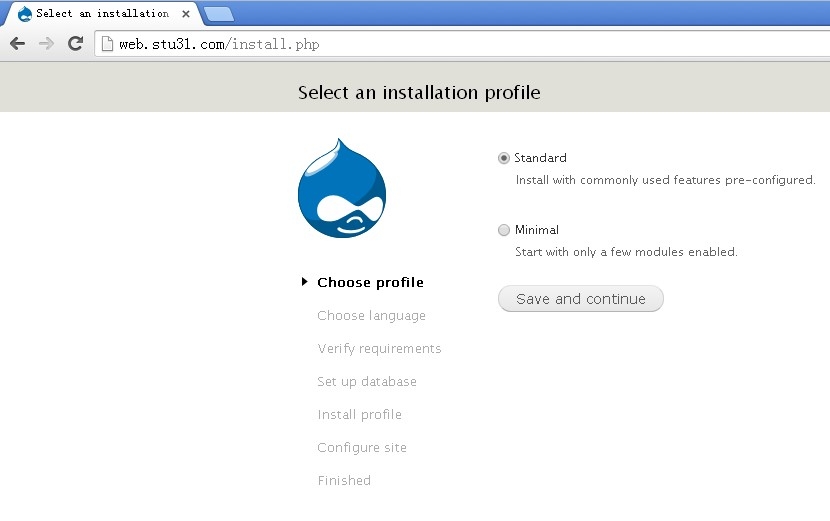
选择简体中文:
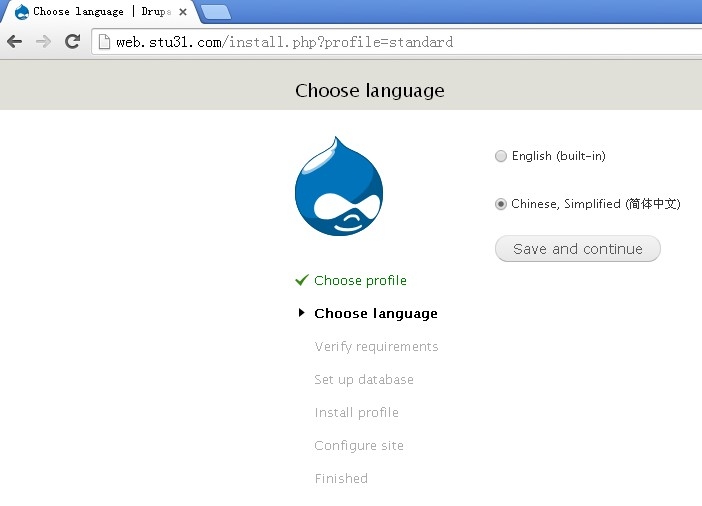
检查安装条件是否通过:
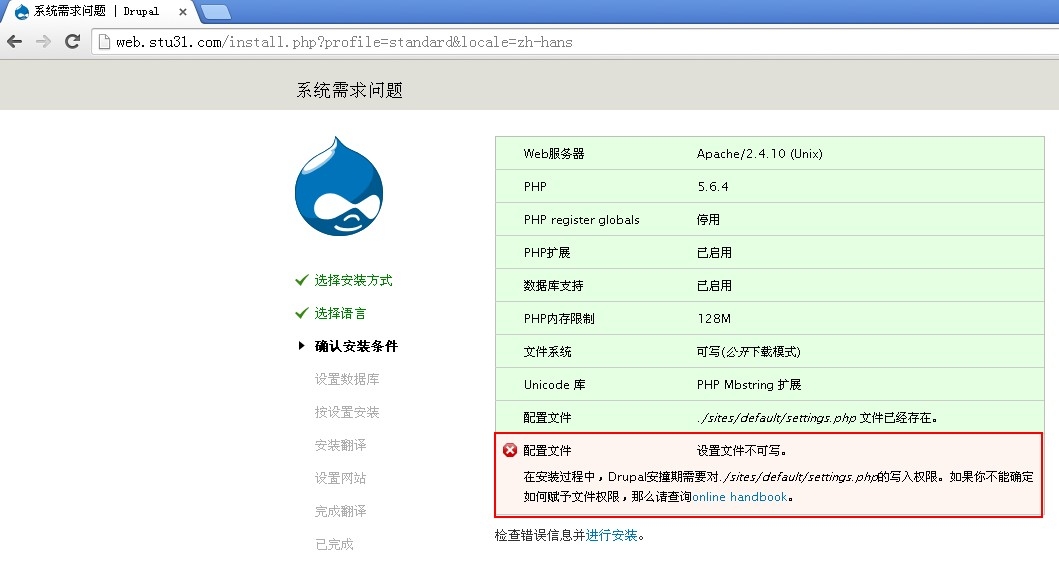
出现不可写,需要对 sites 目录赋予写权限:
需要同时更改 NFS 共享目录和 php 服务器本地的 /www/drupal 目录:
1 2 | [root@php ~]# chmod -R a+w/web/drupal/sites/[root@php ~]# chmod -R a+w /www/drupal/sites/ |
再次刷新安装成功进入下一步:
设置数据库,填入我们在上面设置的数据库名称和用户名及密码
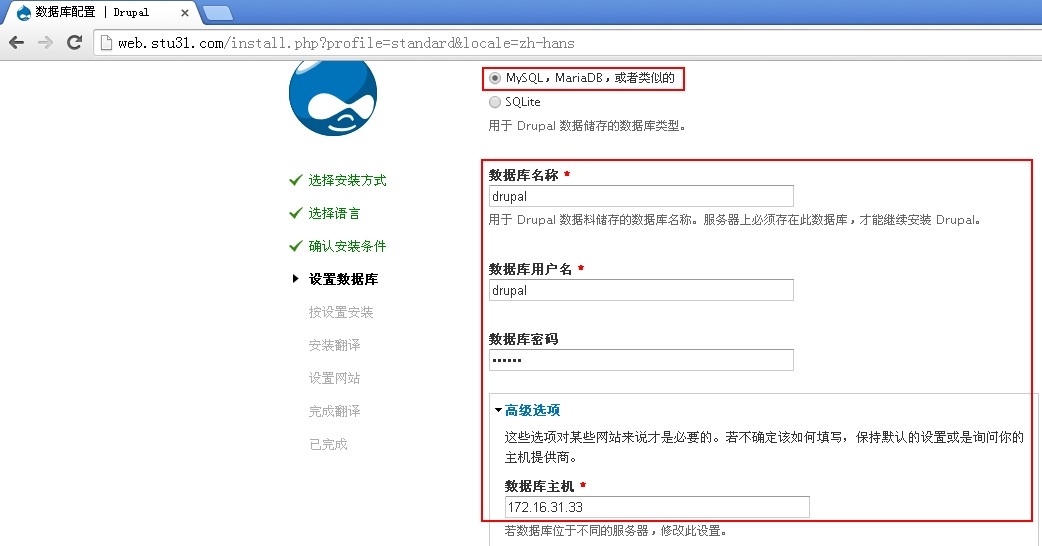
安装模块:
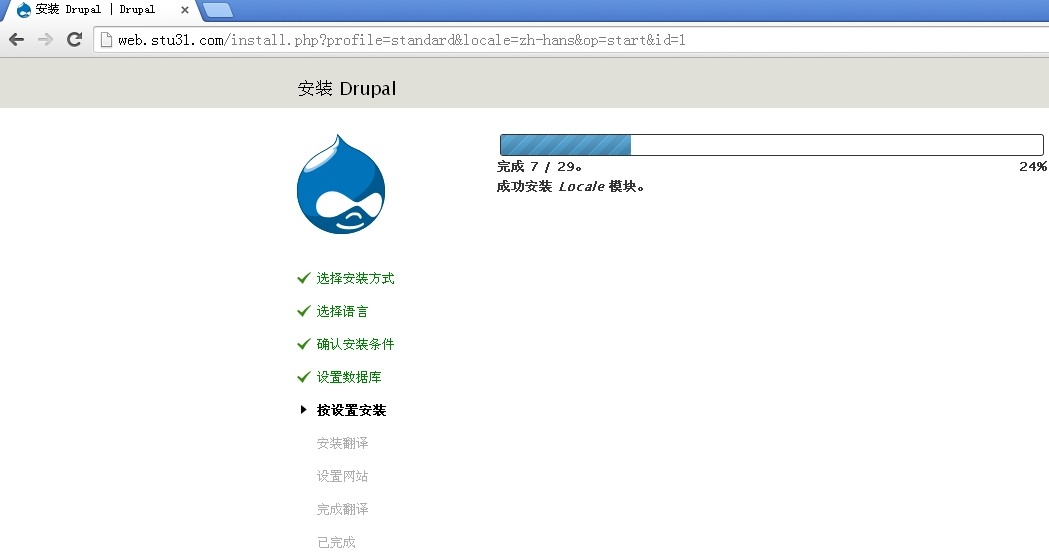
设置网站:

完成安装:
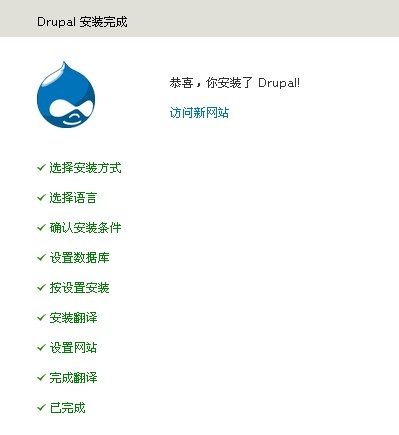
进入网站首页:

安装完成后将 sites/default/settings.php 的权限更改为只读权限,考虑到安全:
1 2 | [root@php ~]# chmod 444/web/drupal/sites/default/settings.php[root@php ~]# chmod 444/www/drupal/sites/default/settings.php |
到这里 drupal 网站安装就完成了!!!




















